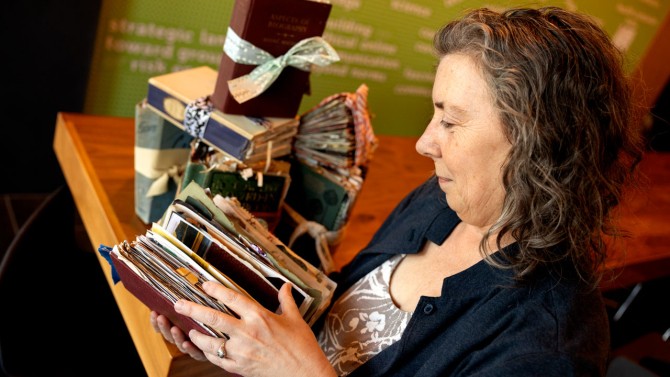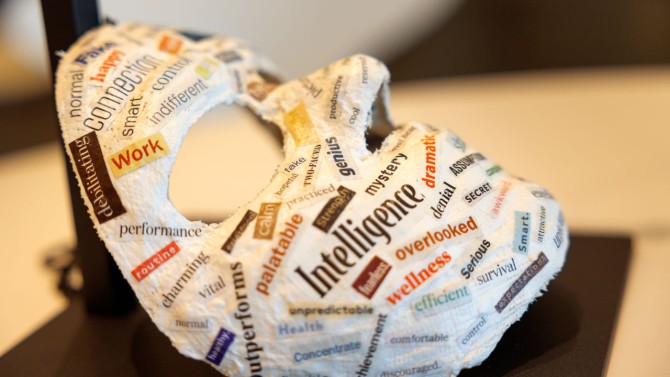
Hilary Anne Yarger, engagement and outreach coordinator at the Language Resource Center, with her submission for “Invisible Aspects of Disability and Neurodiversity,” an arts exhibition that gives people with disabilities and neurodivergent people a platform to express unseen aspects of their identities.
Art exhibition sheds light on invisible aspects of disability
By Caitlin Hayes, Cornell Chronicle
Ria Gualano knows something about invisibility. Being multiracial and living with an unseen chronic illness, she’s felt at times there were large swaths of her life few people knew or understood.
But one thing that helps is expressing herself through art.
Now Gualano, a doctoral student in communication, is giving others with disabilities in the Cornell community a chance to express unseen aspects of their own identities in an upcoming arts exhibition. “Invisible Aspects of Disability and Neurodiversity” opens April 25 from 4:30-6:30 p.m. and runs through May 3 in the Department of Communication, on the fourth floor of Mann Library.
“I wanted to create a space that would be generative and rich for contributors, to provide them with an opportunity for self-expression and identity exploration, as disability arts had helped me in my personal journey,” Gualano said.
Another aim of the show is to raise visibility and awareness of the experiences of people with disabilities, Gualano said, and to dispel misconceptions and preconceptions.
“There are so many stereotypes,” she said. “But creating our own representations and uplifting the voices of neurodivergent people and people with disabilities allows us to be in control of the narrative, rather than letting other people interpret our lives for us.”
Nine participants, a mix of students and staff members, have contributed art for the show, and the opening will include interactive activities – audience members will be able to collaborate on a word cloud in response to each piece of art and add to a general response wall and an audience-created collage.
Gualano said the art in the exhibition is mostly visual but created with mixed media. Ashlee Cherry, class programs event manager in Alumni Affairs and Development, is submitting a plaster mask of her face that she covered with words from magazines, to represent the difficulty of masking the symptoms of her neurodiversity and chronic illness. Hilary Anne Yarger, engagement and outreach coordinator at the Language Resource Center, knitted a self-portrait, using muted colors and a draping shape that represents the exhaustion she often feels. Andria Auerrell, senior instructional designer for eCornell’s Learning Services Group, created a sculpture with vintage books to represent the busyness of her mind. Gualano herself will contribute fashion sketches that express the intersection between her identities as a multiracial woman with an invisible disability.
“I think the show allows contributors to explore what they can do with different art mediums to expand their communication toolkit,” Gualano said. “And it allows them to infuse their work with representations unique from other forms of communication.”
Planning for the exhibition began early in the fall of 2023, and contributors – who did not need any art experience to participate – attended a series of optional workshops where they could provide input and prepare their art. Gualano helped them brainstorm ideas and gave them time and space to work and connect with each other.
“I wanted to give contributors as many opportunities for input as possible throughout this planning process in hopes it could culminate in an event we can all be proud of,” Gualano said.
After the show, participants will have the option to engage in follow-up interviews for Gualano’s research on the overall experience, which she hopes will generate guidelines for future events and contribute to a growing area of inquiry around how disability can be communicated through arts and exhibition-based work.
“Before I began planning this exhibition, I already knew I was interested in studying disability and neurodiversity arts and building theory through people’s lived experiences,” Gualano said. “But I also wanted to find ways to provide opportunities and a platform to others, too, and give back to the community.”
Media Contact
Abby Kozlowski
Get Cornell news delivered right to your inbox.
Subscribe


